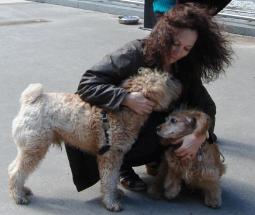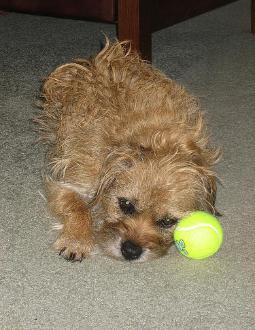Strategies for working with the fearful dog
copyright (c) 2021 Frania Shelley-Grielen. All rights reserved.
What can you do to help a dog that is afraid? I work with fearful dogs and I want to
help each one of them and their owners. What breed this dog is or even what sex
the dog is immaterial. This particular dog could be any number of fearful dogs on
the island of Manhattan. You may have walked by this dog this morning on your
way to the subway at West 4th Street or passed by on your way home getting off
the M116 cross-town.
I have written on working with the individual aggressive dog, aggression between
dogs, and bite prevention in dogs, all of which include basic guidelines in
approaching all dogs, including the overly fearful dog. Here I want to outline some
specific "hands on" strategies and approaches for the fearful dog. This is no way
exhaustive nor can it deal with every specific situation. Every animal is an
individual and every approach should be individualized based on history and
presentation:
This is not where I wish you luck; rather assure you that patience, time and
compassion are you and your dogs’ best friends
This article is an original work and is subject to copyright. You may create a link to
this article on another website or in a document back to this web page. You may not
copy this article in whole or in part onto another web page or document without
permission of the author. Email inquiries to info@animalbehaviorist.us
copyright (c) 2021 Frania Shelley-Grielen. All rights reserved.
What can you do to help a dog that is afraid? I work with fearful dogs and I want to
help each one of them and their owners. What breed this dog is or even what sex
the dog is immaterial. This particular dog could be any number of fearful dogs on
the island of Manhattan. You may have walked by this dog this morning on your
way to the subway at West 4th Street or passed by on your way home getting off
the M116 cross-town.
I have written on working with the individual aggressive dog, aggression between
dogs, and bite prevention in dogs, all of which include basic guidelines in
approaching all dogs, including the overly fearful dog. Here I want to outline some
specific "hands on" strategies and approaches for the fearful dog. This is no way
exhaustive nor can it deal with every specific situation. Every animal is an
individual and every approach should be individualized based on history and
presentation:
- Work with and find the right behaviorist and/or trainer, one that is well
- qualified and utilizes force free positive methods. And training classes,
especially puppy kindergarten can be the number one mitigating factor in
dealing with the fearful dog. The structured environment gives the dog
much needed defined boundaries and rewards. Only work with programs
that utilize positive reinforcement. Positive reinforcement is far more
effective in insuring new and positive behaviors as opposed to aversive
strategies, especially with fearful dogs.
- Read a good book on dog training from the right sources. Ian Dunbar, Patricia
- McConnell, Sophia Yin, Pat Miller, Paul Owens, Victoria Stillwell and Suzanne
Clothier are all wonderful to choose from for starters.
- Let "ignore the bad behavior, reward the good behavior" become your mantra
- and apply it always. Work on actively noting the good behavior. A dog simply
lying quietly can be praised for it ("Good Dog to lie Quiet!"). Your dog loves
praise, especially coming from you. Capitalize on the positive moments, this
way you get to build much needed confidence in your dog on a more frequent
basis.
- Go slowly, more slowly than you want to or than you think you should. The
- dog is afraid, that trembling, urinating or barking is all that the dog has to
communicate this to you. Respect it. We animal people want every animal to
connect with us in instant intimacy, this is not about you it's about the dog.
- This is not the time to ask for compliance, "Calm, submissive" is the antithesis
- of what you want from this dog. Forcing this dog (or "flooding") to do anything
will exacerbate the situation and make the dog's issue larger not to mention it
is simply cruel and inhumane.
- Speak softly, and lower yourself to the dog's level. Do not approach initially
- and avoid eye-contact. Never tower over the dog. A downward pat towards
the head will also not be welcome, try an offering your hand halfway out
from your body with the palm downward and your eyes downcast.
- When you do approach (when the dog has calmed a bit) approach laterally
- (sideways). Direct eye contact and frontal approaches are aggressive
behavior in a dog's world.
- Allow for the time the process will take. Or ask for a lot and be happy with a
- little. It may take several weeks or even months for your dog to accept novel
situations or people and only after repeated attempts.
- Reassurance is not a dirty word. You can reassure your dog. Keep it to one or
- at the most two short sentences in a calm, even tone, the sky is not falling, it's
OK to point that out and remember not to act as if it is.
- Set your dog up for success. If a street-cleaner, larger dog, group of toddlers,
- etc., is coming towards you, put your body between them and the dog. Your
physical presence as a buffer will alleviate stress in these situations.
- Figure out what amplifies the positive for your dog. High value treats may
- be welcome at other times but are hard to process when on the defensive. The
dog I am working with responded from day one to tons of praise in a sing-song
happy voice and loves to chase the tennis ball. We play a lot of ball.
This is not where I wish you luck; rather assure you that patience, time and
compassion are you and your dogs’ best friends
This article is an original work and is subject to copyright. You may create a link to
this article on another website or in a document back to this web page. You may not
copy this article in whole or in part onto another web page or document without
permission of the author. Email inquiries to info@animalbehaviorist.us
| Working with the fearful dog |

Copyright Frania Shelley-Grielen
| "Go slowly, more slowly than you want to or than you think you should. The dog is afraid, that trembling, urinating or barking is all that the dog has to communicate this to you. Respect it. We animal people want every animal to connect with us in instant intimacy, this is not about you it's about the dog." |

Fishpickdiver
| Schedule a consultation |

info@animalbehaviorist.us
212-722-2509 / 646-228-7813
Website copyright Frania Shelley-Grielen
212-722-2509 / 646-228-7813
Website copyright Frania Shelley-Grielen

We are a member of the Amazon Associates Program, an
affiliate advertising program designed to provide a means
for sites to earn advertising fees by advertising and
linking to Amazon.com.
affiliate advertising program designed to provide a means
for sites to earn advertising fees by advertising and
linking to Amazon.com.
Best viewed in Google Chrome |